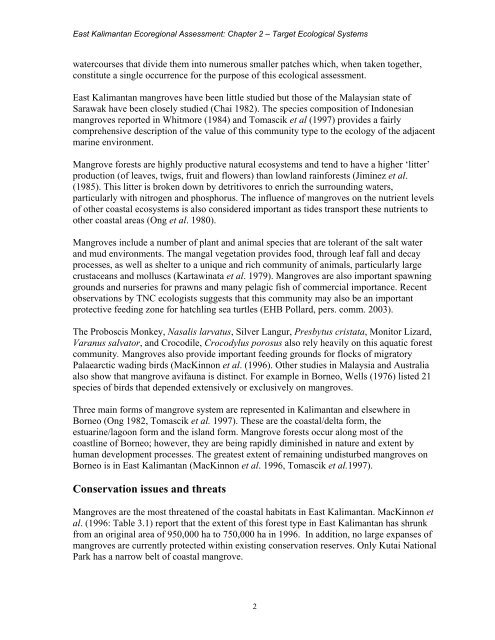Ecoregional Assessment of Biological Diversity in East Kalimantan
Ecoregional Assessment of Biological Diversity in East Kalimantan
Ecoregional Assessment of Biological Diversity in East Kalimantan
You also want an ePaper? Increase the reach of your titles
YUMPU automatically turns print PDFs into web optimized ePapers that Google loves.
<strong>East</strong> <strong>Kalimantan</strong> <strong>Ecoregional</strong> <strong>Assessment</strong>: Chapter 2 – Target Ecological Systems<br />
watercourses that divide them <strong>in</strong>to numerous smaller patches which, when taken together,<br />
constitute a s<strong>in</strong>gle occurrence for the purpose <strong>of</strong> this ecological assessment.<br />
<strong>East</strong> <strong>Kalimantan</strong> mangroves have been little studied but those <strong>of</strong> the Malaysian state <strong>of</strong><br />
Sarawak have been closely studied (Chai 1982). The species composition <strong>of</strong> Indonesian<br />
mangroves reported <strong>in</strong> Whitmore (1984) and Tomascik et al (1997) provides a fairly<br />
comprehensive description <strong>of</strong> the value <strong>of</strong> this community type to the ecology <strong>of</strong> the adjacent<br />
mar<strong>in</strong>e environment.<br />
Mangrove forests are highly productive natural ecosystems and tend to have a higher ‘litter’<br />
production (<strong>of</strong> leaves, twigs, fruit and flowers) than lowland ra<strong>in</strong>forests (Jim<strong>in</strong>ez et al.<br />
(1985). This litter is broken down by detritivores to enrich the surround<strong>in</strong>g waters,<br />
particularly with nitrogen and phosphorus. The <strong>in</strong>fluence <strong>of</strong> mangroves on the nutrient levels<br />
<strong>of</strong> other coastal ecosystems is also considered important as tides transport these nutrients to<br />
other coastal areas (Ong et al. 1980).<br />
Mangroves <strong>in</strong>clude a number <strong>of</strong> plant and animal species that are tolerant <strong>of</strong> the salt water<br />
and mud environments. The mangal vegetation provides food, through leaf fall and decay<br />
processes, as well as shelter to a unique and rich community <strong>of</strong> animals, particularly large<br />
crustaceans and molluscs (Kartaw<strong>in</strong>ata et al. 1979). Mangroves are also important spawn<strong>in</strong>g<br />
grounds and nurseries for prawns and many pelagic fish <strong>of</strong> commercial importance. Recent<br />
observations by TNC ecologists suggests that this community may also be an important<br />
protective feed<strong>in</strong>g zone for hatchl<strong>in</strong>g sea turtles (EHB Pollard, pers. comm. 2003).<br />
The Proboscis Monkey, Nasalis larvatus, Silver Langur, Presbytus cristata, Monitor Lizard,<br />
Varanus salvator, and Crocodile, Crocodylus porosus also rely heavily on this aquatic forest<br />
community. Mangroves also provide important feed<strong>in</strong>g grounds for flocks <strong>of</strong> migratory<br />
Palaearctic wad<strong>in</strong>g birds (MacK<strong>in</strong>non et al. (1996). Other studies <strong>in</strong> Malaysia and Australia<br />
also show that mangrove avifauna is dist<strong>in</strong>ct. For example <strong>in</strong> Borneo, Wells (1976) listed 21<br />
species <strong>of</strong> birds that depended extensively or exclusively on mangroves.<br />
Three ma<strong>in</strong> forms <strong>of</strong> mangrove system are represented <strong>in</strong> <strong>Kalimantan</strong> and elsewhere <strong>in</strong><br />
Borneo (Ong 1982, Tomascik et al. 1997). These are the coastal/delta form, the<br />
estuar<strong>in</strong>e/lagoon form and the island form. Mangrove forests occur along most <strong>of</strong> the<br />
coastl<strong>in</strong>e <strong>of</strong> Borneo; however, they are be<strong>in</strong>g rapidly dim<strong>in</strong>ished <strong>in</strong> nature and extent by<br />
human development processes. The greatest extent <strong>of</strong> rema<strong>in</strong><strong>in</strong>g undisturbed mangroves on<br />
Borneo is <strong>in</strong> <strong>East</strong> <strong>Kalimantan</strong> (MacK<strong>in</strong>non et al. 1996, Tomascik et al.1997).<br />
Conservation issues and threats<br />
Mangroves are the most threatened <strong>of</strong> the coastal habitats <strong>in</strong> <strong>East</strong> <strong>Kalimantan</strong>. MacK<strong>in</strong>non et<br />
al. (1996: Table 3.1) report that the extent <strong>of</strong> this forest type <strong>in</strong> <strong>East</strong> <strong>Kalimantan</strong> has shrunk<br />
from an orig<strong>in</strong>al area <strong>of</strong> 950,000 ha to 750,000 ha <strong>in</strong> 1996. In addition, no large expanses <strong>of</strong><br />
mangroves are currently protected with<strong>in</strong> exist<strong>in</strong>g conservation reserves. Only Kutai National<br />
Park has a narrow belt <strong>of</strong> coastal mangrove.<br />
2

















